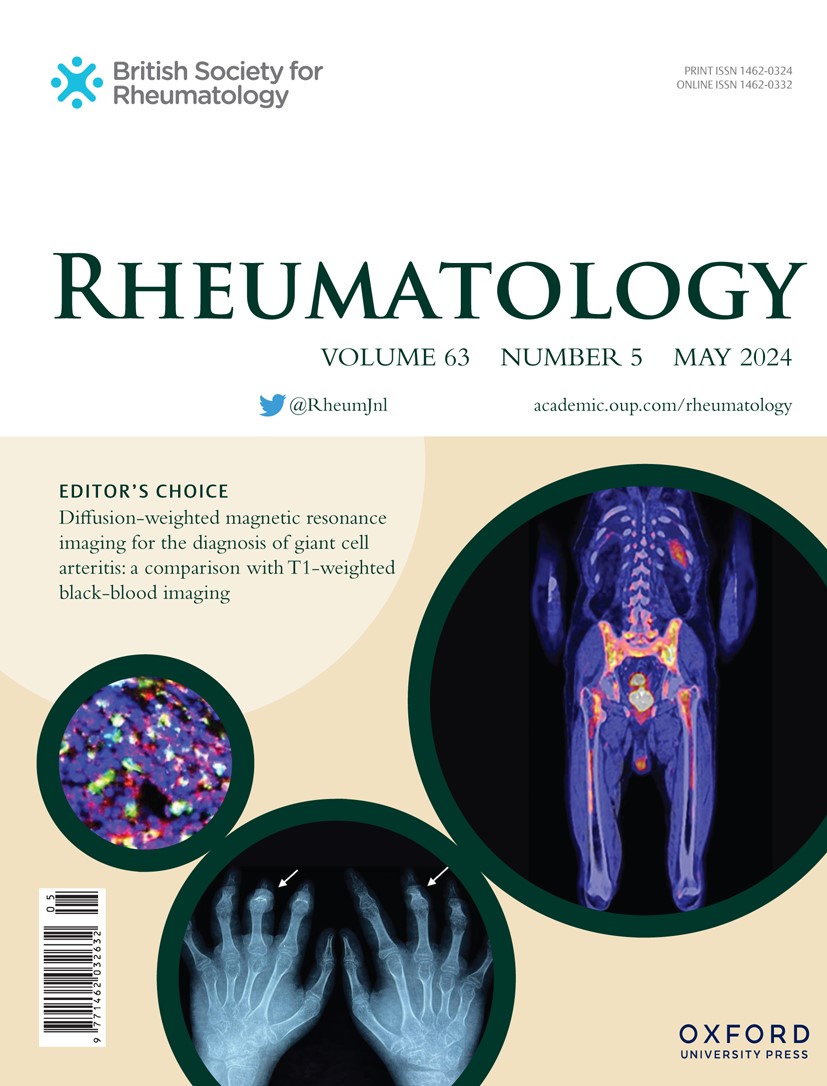基于mri的患者特异性nomogram早期膝骨关节炎诊断风险分层
IF 4.7
2区 医学
Q1 RHEUMATOLOGY
引用次数: 0
摘要
本研究旨在建立基于磁共振成像(MRI)的早期骨关节炎(OA)风险分层图,特别是MRI潜在序列称为T1rho和T2映射。方法收集诊断为早期OA或正常的软骨,经MRI检查后分为训练组和验证组。确定了11个预测因子作为oa解剖特征图(OA-ASN)的候选预测因子。采用一致性指数(C-index)、受试者工作特征曲线下面积(AUC)、标定图、决策曲线分析(DCA)和临床影响曲线(CIC)评价OA-ASN的性能。结果共评估199例患者。其中79例(39.7%)为早期OA。在多变量分析中,髌下脂肪垫(IPFP)、T1 rho和T2映射与早期OA独立相关。包含这些变量的nomogram具有很好的判别性(C-index, 0.975;训练样本(n = 115)和bootstrap验证(C-index, 0.96)的C-index为0.904 (95% CI: 0.840, 0.959),验证队列(n = 84)的C-index为0.904 (95% CI: 0.840, 0.959)。校正图显示,在训练和验证队列中,模态图的预测结果与实际观察结果具有良好的一致性。DCA和CIC显示nomogram临床应用价值。结论IPFP体积较小,T1ρ值&;gt;33、T2映射&;gt;35.04例与OA显著相关。OA-ASN具有良好的预测结果,基于生理MRI的观察性筛查方法易于获取和简单,可以提供个性化的治疗策略。本文章由计算机程序翻译,如有差异,请以英文原文为准。
MRI-based patient-specific nomogram for diagnostic risk stratification of patients with early knee osteoarthritis
Objectives This study is to develop a risk stratification nomogram for early-stage osteoarthritis (OA) based on magnetic resonance imaging (MRI), especially with potential sequences of MRI called T1rho and T2 mapping. Methods Cartilages diagnosed with early-stage OA or normal were collected and allocated into training or validation cohorts after the MRI. Eleven predictors were determined as candidate predictors for OA-anatomical signature-nomogram (OA-ASN). The performance of OA-ASN was evaluated using the concordance index (C-index), the area under the receiver operating characteristic curve (AUC), calibration plots, decision curve analysis (DCA), and clinical impact curve (CIC). Results A total of 199 patients were evaluated. Of these, 79 (39.7%) had early OA. infrapatellar fat pad (IPFP), T1 rho, and T2 mapping were independently associated with early-stage OA at multivariable analysis. The nomogram incorporating these variables displayed excellent discrimination (C-index, 0.975; 95% CI: 0.951, 0.999) in the training sample (n = 115) and bootstrap validation (C-index, 0.96), while C-index was 0.904 (95% CI: 0.840, 0.959) in the validation cohort (n = 84). The calibration plots showed favorable consistency between the prediction of the nomogram and actual observations in both the training and validation cohorts. The DCA and CIC showed that the nomogram was clinically useful. Conclusions A smaller volume of IPFP, T1ρ value > 33, and T2 mapping > 35.04 were significantly associated with OA. The OA-ASN demonstrated excellent predictive outcomes with easy-accessible and simple observational screening methods based on physiological MRI, which can provide individual treatment strategies.
求助全文
通过发布文献求助,成功后即可免费获取论文全文。
去求助
来源期刊

Rheumatology
医学-风湿病学
CiteScore
9.40
自引率
7.30%
发文量
1091
审稿时长
2 months
期刊介绍:
Rheumatology strives to support research and discovery by publishing the highest quality original scientific papers with a focus on basic, clinical and translational research. The journal’s subject areas cover a wide range of paediatric and adult rheumatological conditions from an international perspective. It is an official journal of the British Society for Rheumatology, published by Oxford University Press.
Rheumatology publishes original articles, reviews, editorials, guidelines, concise reports, meta-analyses, original case reports, clinical vignettes, letters and matters arising from published material. The journal takes pride in serving the global rheumatology community, with a focus on high societal impact in the form of podcasts, videos and extended social media presence, and utilizing metrics such as Altmetric. Keep up to date by following the journal on Twitter @RheumJnl.
 求助内容:
求助内容: 应助结果提醒方式:
应助结果提醒方式:


